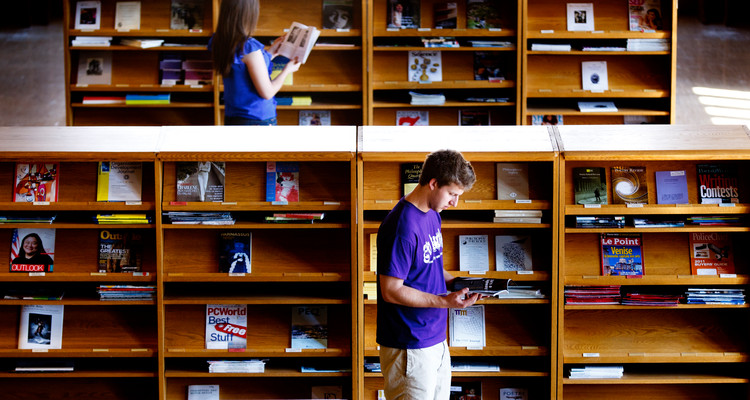Maintaining the collection in the St. Thomas libraries could be described as a balancing act: What should be added? In what format? What should be kept?
“We always say selecting material for the collection and deciding what to keep is much more an art than a science,” said Meg Manahan, associate director for collection and management services.
Three primary goals guide many decisions: supporting the curriculum, maintaining a vibrant and well-rounded collection, and supporting faculty research. To achieve those goals, departments are assigned a library liaison whose job is to communicate with faculty members on what classes they will teach and what their research interests are. The liaisons strive to maintain balance within their own subjects, making sure one area isn’t lean while another is excessive.
While that might sound like a simple task, it involves staying up to date in a liaison’s given area and sometimes foreseeing a need before the request even arrives.
Ann Kenne, the liaison for Catholic Studies, History and Irish Studies, said she paid attention to books that were coming out on World War I a few years ago because she knew the 100th anniversary was near. When the anniversary arrived and a class did materialize, Kenne already had a core set of materials ready.
“I’m cognizant of the trends that are going on in the field, the big anniversaries and things that are coming up,” Kenne said.
She said she also considers if a resource is something that could be used in other departments.
Print or digital?
Besides subject matter, the library staff also examines what format may best serve readers. Manahan said that often varies by department, although many journals now appear in electronic format. E-books are an entirely different matter.
“That’s something we talk a lot about,” Manahan said. “How much our St. Thomas users really want e-books or will use them, how much they prefer print and what the balance should be. Right now, we’re buying both. … We leave it up to the liaison to know their department.”
Kenne said for her departments she considers how the texts – and what parts – will be used. If a reader might only be reading a chapter or two, or popping in and out of an article, she might lean toward electronic. She said, overall, humanities at St. Thomas still tend toward print.
“If you’re dealing with a book you want to have some reflective time, and it’s hard to do reflective reading with a screen,” Kenne said.
Manahan said that, increasingly, they’re also starting to regard the collection more broadly: by what can be accessed through other libraries.
“We really try to utilize every resource available to us (and) try to get materials from any library, anywhere, to really support what (faculty is) doing,” Manahan said.
Of course, with a finite amount of physical space, sometimes books must be removed from the collection. Manahan emphasized that they’re “really, really thoughtful about removing material.”
“We consider ourselves to have some role in preserving the scholarly record,” Manahan said.
She said they examine how often a text is used and how current it is. Books with some wear and tear can either be rebound or repurchased, depending on what is most cost effective. Books that are removed from the collection are first put up for sale at the annual book sale and then donated to Better World Books, which either donates them, sells them and donates the funds to literacy efforts, or recycles them.
Manahan and Kenne both emphasized that all members of the St. Thomas community, and particularly students, should feel comfortable to make requests through the Book Purchase Request Form.
“Our overall message is that we try to have a collection that is vibrant, active, well-rounded and well-used,” Manahan said. “The collection is unique to our institution, so we want to make sure it’s appropriate.”







